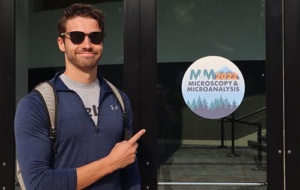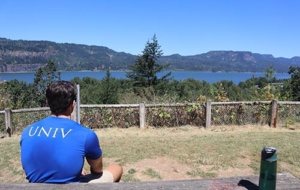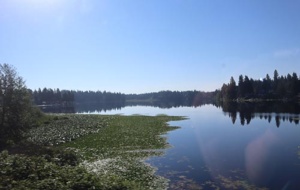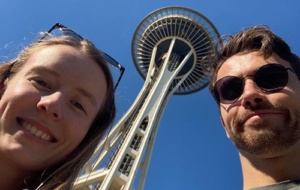Microscopy and Microanalysis 2022
 Univ Old Members’ Trust Graduate Travel Report – Andrew Bridger (2020, DPhil Inorganic Chemistry)
Univ Old Members’ Trust Graduate Travel Report – Andrew Bridger (2020, DPhil Inorganic Chemistry)
Over the start of August 2022, I was fortunate enough to be able to attend the Microscopy and Microanalysis conference in Portland, Oregon, US of A. This was to be the first in person presentation of my DPhil, finally free from the constraining bounds of the Zoom box and let loose on a live audience. I found this prospect both exciting and daunting in equal measure. While zoom presentations can feel like talking into a void, I’ve always managed to find some comfort in the fact that the absence of any audience feedback at all, will guarantee that feedback can’t be bad. Despite the loss of this safety net, I was still looking forward to the chance to present and talk about my work, see some of the rest of the work going on and meet some of our collaborators for the first time in person.
 Travel to the conference took all manner of media, including but not limited to planes, trains, and automobiles. Driving to Thornhill Park and Ride, Bussing to Heathrow, Flying in to Seattle, taking the quintessentially American “Amtrak Cascades Train Service to Portland”, and cycling to the Oregon Convention Centre (courtesy of Portland’s electric bike rental scheme). While all this travel and the 8-hour time shift wreaked havoc on the body clock, it was worth it for four glorious days of microscopy (and microanalysis).
Travel to the conference took all manner of media, including but not limited to planes, trains, and automobiles. Driving to Thornhill Park and Ride, Bussing to Heathrow, Flying in to Seattle, taking the quintessentially American “Amtrak Cascades Train Service to Portland”, and cycling to the Oregon Convention Centre (courtesy of Portland’s electric bike rental scheme). While all this travel and the 8-hour time shift wreaked havoc on the body clock, it was worth it for four glorious days of microscopy (and microanalysis).
The conference sessions began on Monday 1 August with some Plenary talks on scientific communication and the role of microscopy in disease control research. This was followed by the meeting awards and then three and a half days of symposia. My presentation was scheduled for Tuesday morning in the session “C04.2 – Artificial intelligence, instrument automation and high-dimensional data analytic for microscopy and microanalysis” where I gave my equally compactly titled talk “Versatile Automated Domain Mapping of 4D-STEM Data Utilising Unsupervised ML Algorithms and Statistical Analysis”. While I will admit that the talk itself is largely a blur, it was a fantastic experience and was an invaluable opportunity to work on some of the scientific communication skills that had been discussed in the very first talk. It also provided the opportunity for hopefully some future collaborations, as after the presentation I spoke with other some researchers interested in similar work.
 Perhaps even more useful than giving my own presentation, was attending the other presentations, particularly the other C04 data-analytics talks. It is definitely one of the strong suits of data analysis in microscopy, that the field standard is open-source software. This means that not only are the presentations showcasing new and interesting data-analysis methods, but almost always the methods are directly available for use. This makes attending other presentations really exciting, as you are exposed to half a dozen new techniques you could apply to your data, and you don’t have to do any of the heavy lifting yourself (at least from a coding standpoint). Alongside the data-analytics talks, I also attended some more traditional microscopy talks, specifically focussed on similar material systems to the one that we research, and these were similarly interesting and useful.
Perhaps even more useful than giving my own presentation, was attending the other presentations, particularly the other C04 data-analytics talks. It is definitely one of the strong suits of data analysis in microscopy, that the field standard is open-source software. This means that not only are the presentations showcasing new and interesting data-analysis methods, but almost always the methods are directly available for use. This makes attending other presentations really exciting, as you are exposed to half a dozen new techniques you could apply to your data, and you don’t have to do any of the heavy lifting yourself (at least from a coding standpoint). Alongside the data-analytics talks, I also attended some more traditional microscopy talks, specifically focussed on similar material systems to the one that we research, and these were similarly interesting and useful.
After four long days of presentations, symposia and posters, the conference came to a close. I am extremely grateful for the opportunity to attend and all of the new ideas and opportunities that I have gotten out of it. I’m also extremely grateful of the funding from the Old Members’ Trust to help cover the considerable travel and accommodation costs and allowing me to attend such a fantastic event.
 After the conference ended, I remained in America for the following week, self-funded, and got the opportunity to explore some of the national parks and other sights in Oregon and neighbouring Washington. Some of the most notable being Multanomah Falls, The Space Needle and Cannon Beach. I was joined by my girlfriend, Univ MBiochem Alumni, and UCBC-hanger-on Sophie Wicken, who took most of the pictures attached (certainly all the good ones).
After the conference ended, I remained in America for the following week, self-funded, and got the opportunity to explore some of the national parks and other sights in Oregon and neighbouring Washington. Some of the most notable being Multanomah Falls, The Space Needle and Cannon Beach. I was joined by my girlfriend, Univ MBiochem Alumni, and UCBC-hanger-on Sophie Wicken, who took most of the pictures attached (certainly all the good ones).
Find out more about the range of travel grants and scholarships available to assist Univ students on our Travel Grants page or read further travel reports.
Published: 11 November 2022
